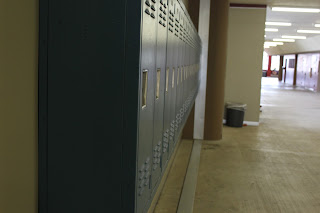Black and White Photographers II For this assignment I will be studying Alvin Langdon Coburn. He was born in Boston, Massachusetts on June 11th, 1882 and died in 1966. His cousin encourages his photography career. He opened a camera studio and joined a camera club. He later went on with Alfred Stieglits, Edward Steichen, Clarence White and Gertrude Kasebier to form the Photo Secession Club. He moved to London, England and became well known for taking portraits for celebrities. He was extremely celebrated on the west and east side of the Atlantic. He was also well known for his abstract photography. Coburn had a great life but not too many exciting things happened. The most exciting thing he got to do is take Theodore Roosevelt's portrait. http://www.amateurphotographer.co.uk/iconic-images/alvin-langdon-coburn-1882-1966-iconic-photographer-12906
Posts
Showing posts from September, 2017
- Get link
- X
- Other Apps

Composition Reflection 1) This example has the lines of the building leading to the hole in the building. I chose this because it seems very profound. 003-1.jpg 2.76 KB 130910-iconic-911-photos-2_mstur6-1.jpg 57 KB 2) For my avoiding mergers example I chose a burning building with an American flag in front of it. I chose this because it also seemed profound. 3) I chose this example for framing because the bridge perfectly points your attention toward the buildings. 4) My simplicity example is a photo from the international space station. It gives an excellent birds eye view of the disaster. 5) I chose this picture for my rule of thirds example. the unaltered towers still stand in the top right third. 6) For my balance example I showed a picture with the Statue of Liberty in the midst of the smoke.
- Get link
- X
- Other Apps

Prompt Shoot Reflection 1.1) I didn't run in to too many problems, but it was a little difficult finding an example for cat. 1.2) I didn't really focus. I just took the picture and finished. 1.3) I would change the aperture and possibly place the camera on a steady surface. 1.4) Everything except for the above reasons. 1.5) Unfortunately, I did not see any of the examples in my photos. 1.6) I would be interested. Taking pictures can be fun and there's always room to improve. 2.1) We had trouble finding something to actually film but that's it. 2.2) I couldn't tell since I was not the one taking the video. 2.3) I would be more interactive in the video. 2.4) I wouldn't want to take the video since my hands aren't very steady. 2.5) Once again I did not see any of the rules in it. 2.6) I would like to do it again some time. It was a fun project that I liked doing as a group.
- Get link
- X
- Other Apps
Composition 9/11 For the first photo I chose point of view. It adds a whole new aspect with a far away shot with the Statue of Liberty in front of it. For the second photo I did the rule of thirds. It is a picture with the World Trade Center before the attack happened in the upper right third. The third photo is a great representation of the lines on the building. It shows the lines being broken up by the hole left by the plane. The fourth photo represents balance and how well the American flag was placed. Here is a photo that frames the burning buildings perfectly. This is personally my favorite photo and avoids mergers amazingly since the photo was shot from space.
- Get link
- X
- Other Apps

Great Black and White Films For my first film I chose The Girl in Red. I chose this because it had an interesting title and I liked how the only color in it was the girl's clothes. This shows symbolism because she is the only one like that. This is actually just a clip of the film, Schindler's list. It is such a simple concept but symbolizes so much. For my second film, I did Schindler's list. It is about the Holocaust and a german man keeping jews to work for his factory and keep them safe. It goes into detail on what happened to them and the whole holocaust. I chose this because the topic is extremely interesting and heartbreaking. I will probably end up watching it and liking it.
- Get link
- X
- Other Apps
Camera History and Basic Function 1. A small hole is put in a wall in a dark room. the light from the other room is focused to this hole and projected onto the other wall but upside down. 2. Sir Isaac Newton perfected the lens. 3. The components were a lens, a dark box and film. 4. They still have a lens and film (some is digital film). The light still goes in through the lens and projects a picture on the film. 5. Digital cameras use digital film to capture the image and then it is stored on a drive. 6. The difference is that "auto" mode automatically does everything for you and almost guarantees a great shot. However you can use "program" mode and put on all of the custom settings you want. 7. Portrait mode blurs out the background to focus on a single person or thing. 8. Sports mode freezes motion and uses the highest shutter speed possible. 9. The photographer has to set f...



